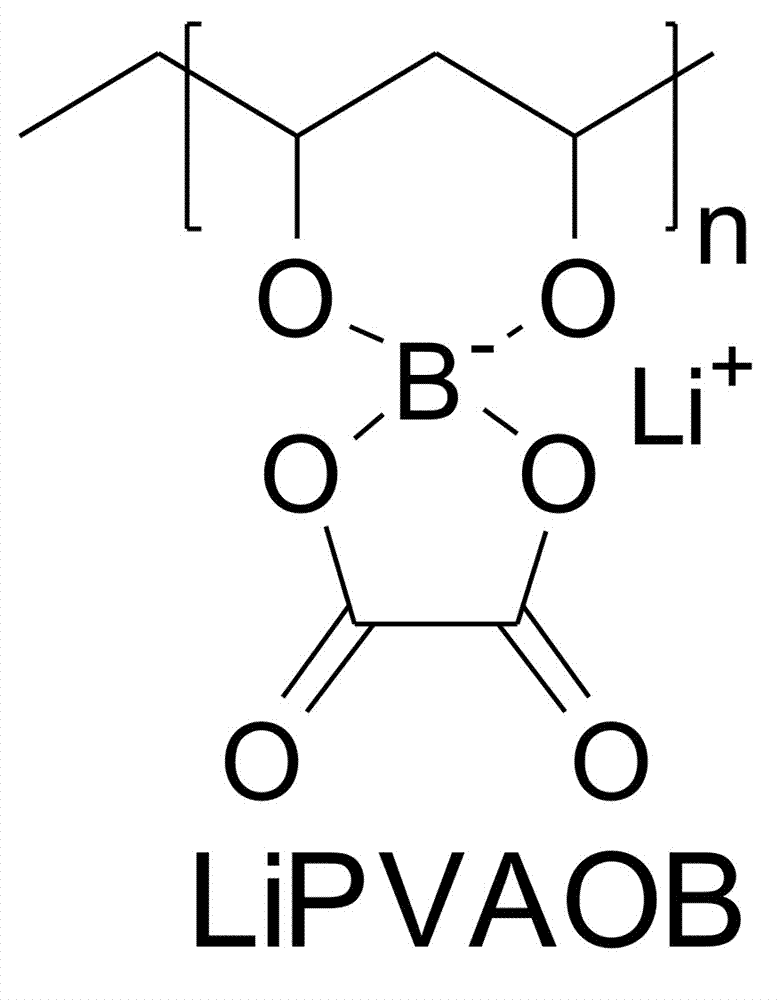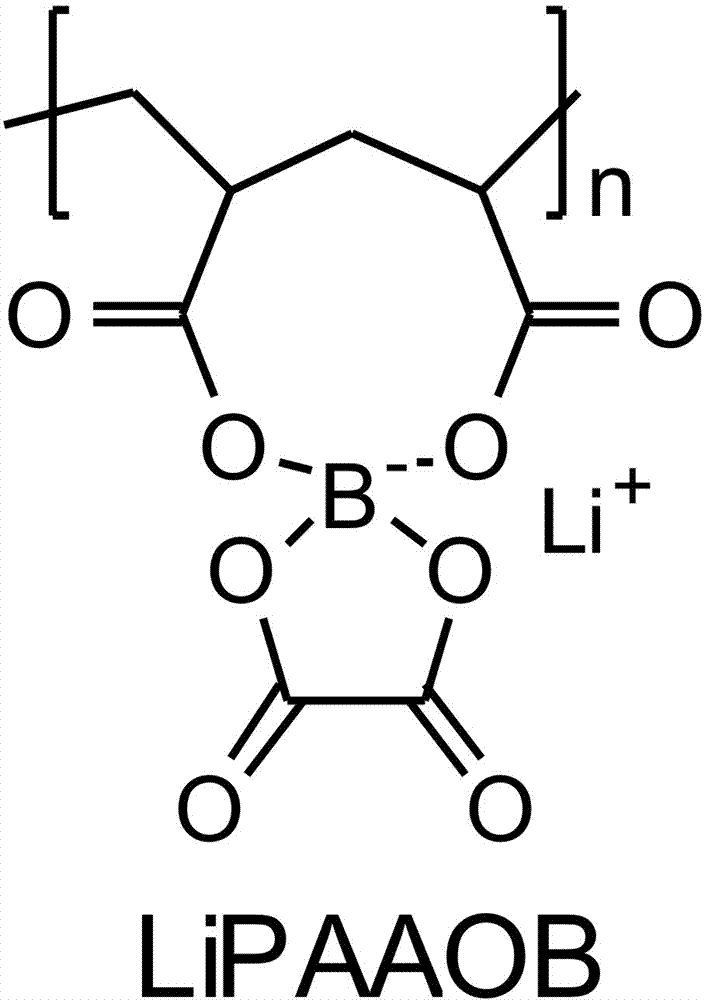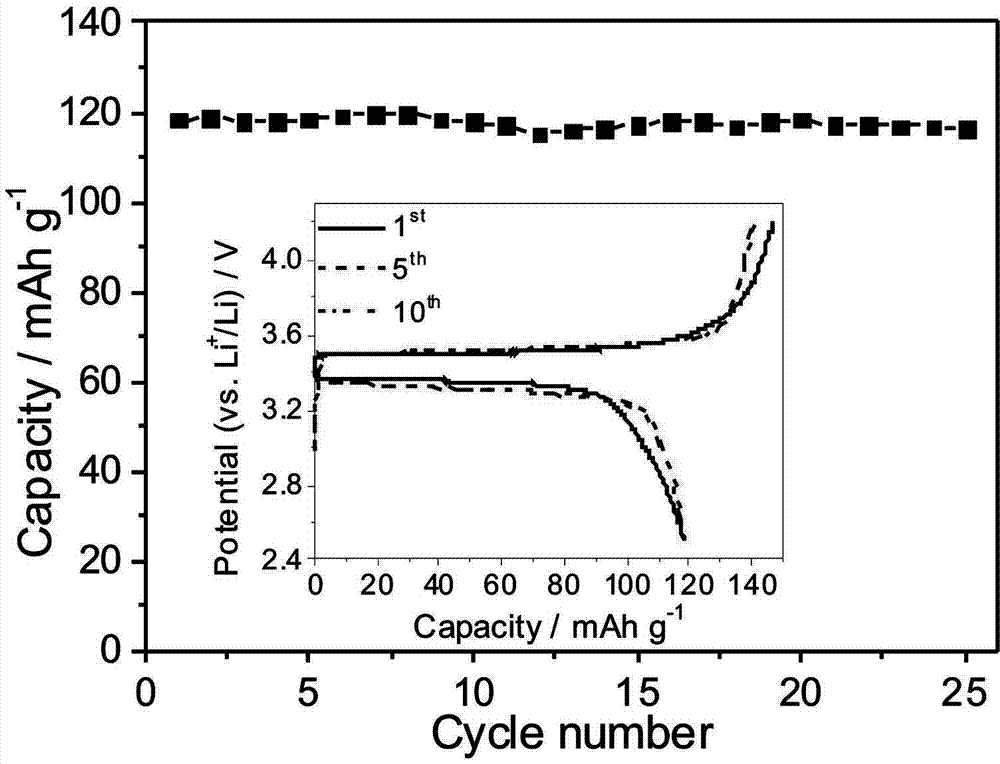Composite gel polymer electrolyte based on solid polymer electrolyte, and preparation method and application thereof
A solid polymer and composite gel technology, applied in the field of lithium-ion batteries, can solve the problems of high anion transfer coefficient, difficulty in wide application, and poor mechanical strength, and achieve good cycle performance, wide electrochemical window, and high mechanical strength. Effect
- Summary
- Abstract
- Description
- Claims
- Application Information
AI Technical Summary
Problems solved by technology
Method used
Image
Examples
Embodiment 1
[0027] (1) Polyethylene oxide (molecular weight: 100,000), LiClO 4 、TiO 2 (particle size 50 nanometers) weighed according to the ratio of 8.7:1:0.3 by mass percentage, heated to 120°C under stirring, turned into a uniform solid solution, and then poured onto a stainless steel plate, pressed to a thickness of 10 microns solid polymer electrolyte membrane and cooled to room temperature.
[0028] (2) In a molten state, a porous polyethylene film with a thickness of 10 micrometers obtained by thermal stretching at 80°C is placed on top of the above-mentioned solid polymer electrolyte membrane, and then heated to 60°C. The solid polymer electrolyte composite membrane was obtained by pressing for 1 hour under the pressure of 10 atmospheres.
[0029] (3) After cutting the above composite film into an appropriate size, place it in a vacuum drying oven at 80 °C for 24 hours to remove trace moisture, cool it to room temperature in vacuum, and transfer it into an anhydrous and oxygen-f...
Embodiment 2
[0043] (1) Dissolve polyvinyl alcohol (PVA, degree of alcoholysis ≥98%, Mw: 105000, 200 mg) and boric acid (148 mg) in 20 ml of DMSO, then heat at 80 °C for 8 hours, A clear solution was obtained. Then add 88 mg Li 2 CO 3 And 300 mg oxalic acid, heated to 100 ° C for 24 hours, cooled to room temperature. The solution was poured onto a glass plate, dried in an oven at 70 °C, and the solvent was removed to obtain poly(vinyl alcohol-boric acid-lithium oxalate) with a thickness of 30 μm, whose structure is shown in Figure 1a , the ion-conducting group is similar to the structure of LiBOB.
[0044] (2) In the molten state, a porous polypropylene film with a thickness of 10 micrometers obtained by thermal stretching at 100 ° C, and then the polypropylene film is placed on the above and below the solid lithium polyborate film, and then heated to 70 ° C , Pressed at 10 atmospheres for 2 hours to obtain a solid polymer electrolyte composite membrane.
[0045] (3) After cutting th...
Embodiment 3
[0048] (1) Polyacrylic acid (PAA, Mw: 450000, 200 g), boric acid (148 g), and 20 ml of deionized water were heated to 80 °C to obtain a transparent solution. Next, 59 g of LiOH and 300 g of oxalic acid were added, heated to 100° C. for 24 hours, and cooled to room temperature. The solution was poured onto a glass plate, dried in an oven at 70°C, and the solvent was removed to obtain poly(acrylic acid-boric acid-lithium oxalate) with a thickness of 30 μm, whose structure is shown in Figure 1b , the ion-conducting group is similar to the structure of LiBOB.
[0049] (2) Dissolve P(VDF-HFP) in N-methyl-2-pyrrolidone at a mass percentage of 10%, and then pour the solution on the poly(acrylic acid-boric acid-lithium oxalate) obtained in the above (1) ) membrane surface, and then heated to 100° C., and vacuum-dried to obtain a solid polymer electrolyte composite membrane.
[0050] (3) After cutting the above composite film to an appropriate size, place it in a vacuum drying oven ...
PUM
| Property | Measurement | Unit |
|---|---|---|
| Thickness | aaaaa | aaaaa |
| Thickness | aaaaa | aaaaa |
| Thickness | aaaaa | aaaaa |
Abstract
Description
Claims
Application Information
 Login to view more
Login to view more - R&D Engineer
- R&D Manager
- IP Professional
- Industry Leading Data Capabilities
- Powerful AI technology
- Patent DNA Extraction
Browse by: Latest US Patents, China's latest patents, Technical Efficacy Thesaurus, Application Domain, Technology Topic.
© 2024 PatSnap. All rights reserved.Legal|Privacy policy|Modern Slavery Act Transparency Statement|Sitemap



